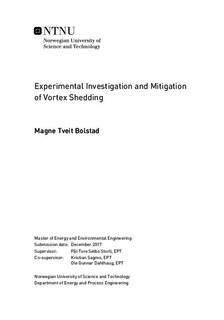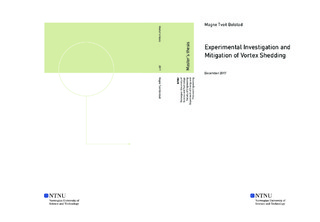| dc.description.abstract | As part of meeting the increase in energy needs and environmental challenges, energy production using intermittent power sources as wind, solar and wave energy has increased.
As a consequence, hydropower plants are exploited for their stabilizing abilities, and are subjected to an increasing number of transient operations e.g. load variations and start-stop operations. This may require turbines to be operated at conditions outside their best efficiency operating points. One of the most common hydropower turbines the Francis turbine is highly sensitive to variations in flow conditions. Efficiency decrease, high frequency noise and pressure pulsations due to rotor stator interaction (RSI) and fluid structure-interaction (FSI) may occur, potentially causing fatal structural failures when operating outside design conditions.
Pressure measurements and simulations of flow around hydrofoils and through a Francis turbine model have been performed at the Waterpower Laboratory at NTNU to gain understanding of these undesired phenomena and structural failures. Experimental determination of the velocity field and its coupling to FSI and RSI is yet to be performed.
In addition, a new hydrofoil design has been suggested in order to mitigate the undesired effects caused by vortex shedding from turbine components e.g. stay vanes, guide vanes and runner blades. The numerical results are promising, but require experimental data to be validated.
The main objective of this thesis has been to acquire experimental measurements of the velocity field in the trailing edge region of hydrofoils and in the vaneless space of a Francis turbine, and investigate its relation to FSI. Two experimental setups have been planned and designed. Measurements using particle image velocimetry (PIV) were performed on one of the two setups, and the velocity field downstream a hydrofoil was determined. Simultaneous measurements of foil vibration were performed to evaluate the degree of FSI, and the acquired data was compared to both previous simulations and relevant experiments.
A dynamic particle seeding system was developed, allowing for PIV measurements of vortex shedding on a large scale piping system. A blade cascade test section was utilized for PIV measurements in the downstream region of a hydrofoil with trailing edge resembling that of a typical Francis runner blade. Measurements of foil vibration allowed for a thorough mapping of the vortex shedding- and foil vibrational frequency both in and around lock-in mode. Lock-in was found to occur in the velocity range 11.1 m/s - 12.1 m/s, at frequencies increasing from approximately to . A significant increase in vortex shedding frequency-stability was found during lock-in. Outside lock-in, the vortex shedding frequency followed the Strouhal law for hydrofoils, where a Strouhal number of 0.22 was found adequate. The measured vortex shedding frequency in lock-in was found to be approximately 21 % higher than the one found through simulations. Due to time-constraints, the suggested design modifications were not implemented, and whether the modifications work as indented or not was not determined.
Due to technical problems and time constraints, no measurements were performed on the Francis-turbine. However, a discussion of the requirements for the experimental setup, together with a description of and recommendations for the setup, has been provided.
Keywords: Hydropower, Francis turbines, Flow-Induced Vibration, FSI, Lock-In, PIV. | en |

